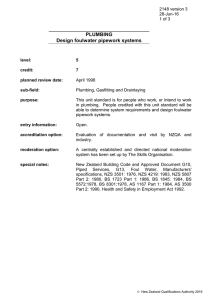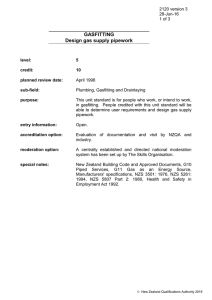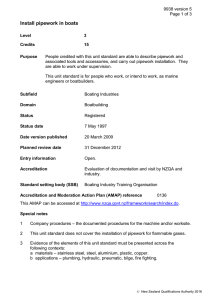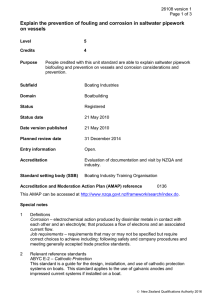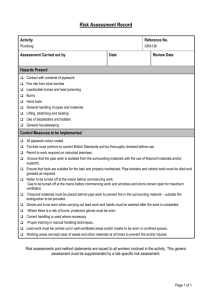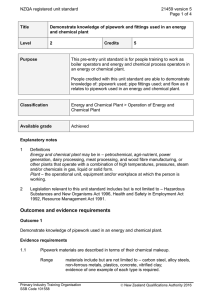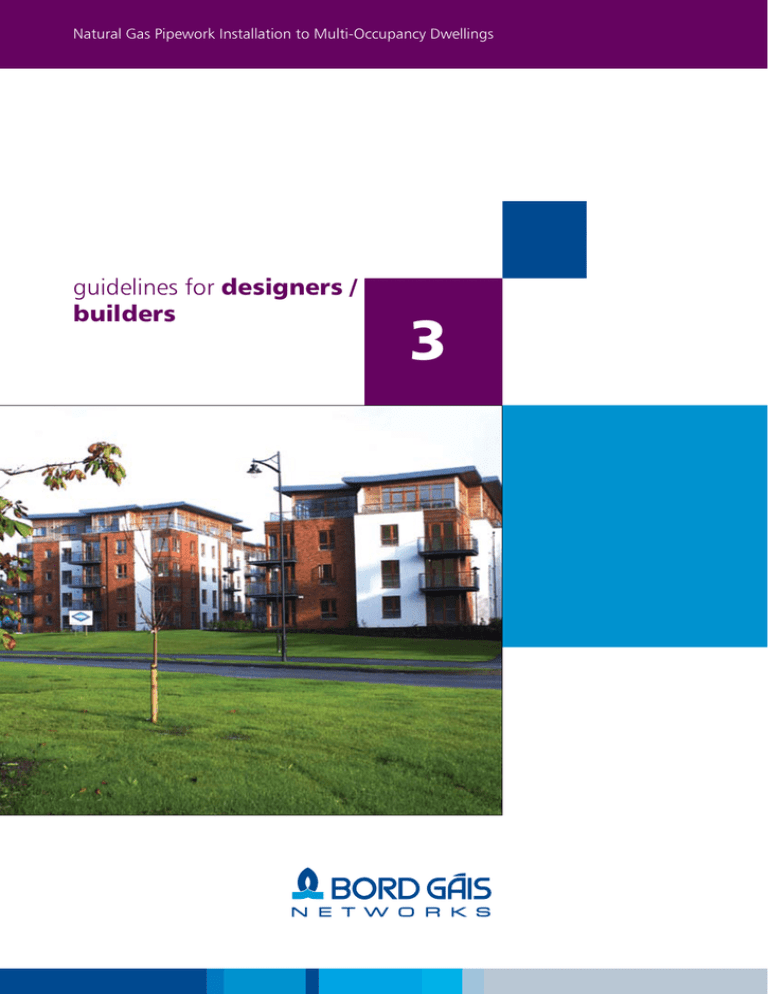
Natural Gas Pipework Installation to Multi-Occupancy Dwellings
guidelines for designers /
builders
3
Contents
Definition of multi-occupancy dwellings
3
Merer locations:
n General Requirements
n Installation up to the Meter
3
3
External Locations
n Meter Cabinets (Pre-Fabricated)
n Meter Banks (Purpose-Built)
4
4
Internal Locations
n Meters in a Common Area
n Meters in Underground Car-Park / Open Basement Area
Marking of Meters
5
6/7
8
Installation Pipework (from Meter to Riser)
n External Underground Pipework
n Internal Underground Pipework
9
10
External Riser Options
n Pipework concealed in Rain Water Down-pipe
n External Risers behind Cladding / Brick
11
12
Internal Riser Options
n Open Riser
n Gas Pipework in Protected Shafts
n Internal Ducts - Continuous
n Internal Ducts - Stopped
n Internal Ducts - Filled
13
13
14
15
16
Installation Pipework - (from riser to welling)
17
n Pipework within the Screed
n Pipework at Ceiling Level
n Bringing Installation Pipework beyond one Apartment to Another
Appendix
n Pipes in Voids
n Isolation Valve
18
Terminology n Terminology & Useful References
19
Gas pipework and other services
20
Irish standards
20
n Your Next Residential Scheme
20
2
Definition
Piped natural gas can be supplied safely and efficiently
to multiple dwellings and the requirements relating to
the installation are to be found in the current edition of
I.S. 813, “Domestic Gas Installations”. A multiple
dwelling of 5 or more floors including a basement
but excluding any plant housing on roof is regarded
as a multi storey building and construction and use
should comply with the Local Government (Multi-Story
Buildings) Act of 1988.
A multi-occupancy dwelling is a building containing
more than two
dwelling units.
A multiple dwelling can be any of
the following:
n A purpose built apartment building
n An existing single dwelling modified to
accommodate a number of separate dwellings, or
NOTE:
n Dwelling units contained in a mixed use building
e.g. shops / offices downstairs with dwelling units
above.
This Booklet is intended for guidance to
the requirements of I.S.813.
This Booklet should not conflict with or
be substituted for I.S.813
Meters locations
All meters must be earth bonded in accordance with
the current edition of the ETCI regulations. Refer to
Booklet 2 for further details.
General Meter Requirements
Provision must be made for easy access to, reading or
removal of a meter.
Installation up to the Meter
Design and or location must protect the meter and it’s
connections against the possibility of corrosion.
Bord Gáis provide and lay all external underground gas
mains, and service pipework up to the point of a meter
location.
Meters must not be located where they may be
exposed to extreme temperatures or ignition sources
(e.g. switch gear).
For trench requirements relating to gas mains and
services, consult Booklet 1 of the Bord Gáis Technical
Manual pages 2, 3 and 4.
Meters must not be located where they may be
exposed to accidental damage.
For details of external installation pipework
requirements from the meter to the dwelling, please
consult pages 9 & 10 of this booklet.
Meters may not be located in a position open to a
stairway unless contained within a compartment per
detail on page 5. Meters must not occupy a space in
any part of a multi-occupancy building which may
hinder escape in the event of an emergency.
All downstream installation pipework, fittings and
auxiliaries of the meter, should be designed so to
operate normally at pressures up to 20mbar.
3
External meter locations
Meters may only be located within the building when
site design cannot facilitate them externally.
The preferred location for meters supplying units in a
multi-occupancy building is in an enclosure, external to
the building.
The structural housing of externally located meters may
be either pre-fabricated or purpose-built (See page 9
- 12, booklet 1 of this guide, and information below).
Dimensions of each six meter cabinet:
1160mm high x 750mm wide x 300mm deep.
Isolation Valve
positioned 2m
minimum from
external Gas
Meters
Fig. 1 Pre-fabricated Meter Cabinet
600mm
min.
cover
Outlet Pipework
63mm P.E. service
pipe
Fig. 2 Purpose-Built Meter Manifold (Suitable for numerous
meter arrangements, See Booklet 1 page 12)
Note:
Pre-fabricated Meter Cabinet:
The compartment must meet the structural and
fire resistant requirements applicable to that part
of the building. All voids within and around
the compartment must be fully sealed
and fire proofed to prevent the ingress
of air or gas to the cavity wall or other
voids.
The cabinet may be concealed with walls at either
side as shown in figure 1. It is not permitted to
recess a multiple meter cabinet into the external wall
of the building, unless all of the requirements below
are met.
Purpose-built Meter Compartment:
If the enclosure opens to the outside but is set
within the building structure then all pipe sleeves
or entries into the building must be sealed with an
approved fire sealing material. Access doors should
not be lockable.
This meter arrangement may be located away from
the building or recessed into the outer leaf of the
building structure.
Ventilation must be provided to atmosphere in
the form of a fully louvred door or in the case of
a solid door, vents must be located at the top and
the bottom of the door. Each vent must provide a
minimum of 5,000mm2 free area or 0.5% of the
compartment floor area, which ever is greater.
If recessed into the structure of the building or to
be placed within the building line, meters must be
in a completely sealed compartment with
the exception of access and ventilation provided by
louvred doors to the outside air. This arrangement is
only permitted on a low pressure site
i.e. service pressure ≤ 100mBar.
4
Internal meter locations
Meters in Common Areas:
n Access doors to the cabinet / compartment
must be lockable and meters must remain
accessible at all times
If the meters supplying the units in a multi-occupancy
building cannot be located externally then they may
be located within the building line subject to the
following:
n The enclosure, including access doors,
must meet the structural and fire resistant
requirements applicable to that part of the
building.
n Low pressure gas network must be available i.e.
service pressure ≤ 100mBar.
n The ventilation to the outside atmosphere
must be provided through suitably sized
and constructed ducts, provided at high and
low level. Ducts should be protected and
constructed to prevent fire damage.
n If the compartment is above ground level, each
vent should provide 5,000mm2 minimum free
area or 0.5% of compartment floor area, which
ever is greater. Separation between the exits of
each ventilating duct to atmosphere must be at
least 450mm apart. If the compartment is to be
positioned below ground level, Bord Gáis must
be consulted for ventilation requirements.
n Meters should be positioned in an area of free
ventilation as close as possible to the external wall
where the gas service pipe enters.
n Meters may not be located beneath a
stairs, unless they are placed within a minimum
two hour fire resistant and sealed compartment
ventilated directly to the outside of the building.
This compartment must not obstruct exits from
the building.
n Provision should be made for a steel service to
enter into the building through a suitable sleeve
where traversing a cavity or void. (See figure 3
below).
n The dimensions required for different meter
arrangements, are available on page 12 of
Booklet 1.
n Care must be taken when locating
the external isolation valve where it
Ducts are required to
provide ventilation for meter
compartment. Ducts should
be sleeved through cavities,
suitably fire rated and provide
minimum air openings as
detailed above.
is freely accessible, e.g. not in a parking area
where vehicles may restrict access.
The enclosure, including access doors, must meet the
structural and fire retardant requirements per Building
Regulations.
Minimum
compartment
dept of 400mm
must be provided
for the manifold,
not including
provision for
enclosure or
protective barrier
External
Isolation
Valve
Area Isolation Valve
600mm
min
Steel Manifold
100mm min cover
From
Mains
At early construction provide Sleeve for Steel Service Pipe.
(Service pipe and manifold provided by Bord Gáis)
Fig. 3
Multiple Meter
Enclosure - within building
5
Note:
Polyethylene pipework is not
permitted inside the building.
Meters located in the
underground car park /
open basement area
Meters located in an underground car park or open
basement area must have direct access to natural
ventilation. Mechanical ventilation may not be relied
upon.
Top-entry cabinets pre-fabricated off site.
Option A:
External
Isolation
Valve
600mm
minimum
cover
required
Dimensions of each six meter cabinet:
1160mm high x 750mm wide x 300mm deep.
Area Isolation Valve
300mm
min.
Contains
Six Meters
Contains Six
Meters
P.E. Pipe
Top-entry cabinets open to
naturally ventilated area
At early construction provide
suitable sleeve for Steel Service
Pipe (Service pipe and manifold
provided by Bord Gáis)
1800mm
max.
Fig. 4 Top-entry cabinets in Underground Car Park / Open Basement Area
Read in conjuncion with pg 7.
n Meters must always be positioned so to avoid the
possibility of impact.
n Provision should be made for the steel service to
enter into the building through an appropriate
sleeve where traversing a cavity or void.
n If it is required that the meters or gas service be
located in a dedicated room within the basement
or in a basement lacking natural ventilation, Bord
Gáis must be consulted for specifications and
ventilation requirements.
n The gas service must pass through a ventilated
area that is publicly accessible (i.e. providing
access for Bord Gáis maintenance at all times).
The gas service may not pass through a protected
corridor / stairway / shaft, refuse area or private
premise (i.e. dwelling or commercial unit).
n Care should be taken when locating the external
isolation valve so it is freely accessible at all times,
e.g. not in a parking area where vehicles may
restrict access.
n Electrical current carrying equipment or cables
must not be in contact with or suspended from
gas equipment or plant.
6
On-site fabricated meter manifold.
Supply pipework supported at ceiling level.
Option B:
External Isolation Valve
600mm minimum
cover required
Area Isolation
Valve
300 mm min
From
Mains
P.E. Pipe
Steel manifold open to
naturally ventilated area
At early construction provide
suitable sleeve for Steel Service
Pipe (Service pipe and manifold
provided by Bord Gáis)
If manifold is at a level exposed to
possible impact, additional provision
must be made with a protective
barrier.
Manifold located
at high level,
minimum depth
required is
400mm.
Fig. 5 Meters in Underground Car Park / Open Basement Area
Read in conjuncion with pg 6.
n The meter installation must not be located directly
beneath a ventilation grill or in a position liable to
cause ingress of water, unless weather protected.
n For the dimensions required for differing meter
manifold arrangements, please consult Booklet 1,
page 12.
n If required at low level a protective barrier must
be placed around the meters. Sufficient impact
resistance provided by the builder.
Top-Entry Cabinets v’s
Steel Manifold:
The top-entry cabinet is tailored for better
on-site co-ordination as the heating installer
can connect directly to the cabinet. The steel
manifold offers greater flexibility in available
meter configurations, but requires on-site
fabrication.
n In the case of the steel manifold protection from
tamper and impact may be provided by the
provision of a suitable steel cage. The use of a
steel mesh casing will allow for ease of meter
reading. The area isolation valve must remain
accessible at all times.
7
Marking of meters
All meters in a multiple meter installation must be
clearly marked to indicate the dwelling number and
floor number supplied by that meter.
Apartment: 1
Floor: Ground
Apartment: 2
Floor: Ground
Apartment: 3
Floor: 1st
Apartment: 4
Floor: 1st
Apartment: 5
Floor: 2nd
Apartment: 6
Floor: 2nd
Fig. 6 Marking of Meters
The marking of meters is essential for safe
operation, maintenance and accurate billing
of gas consumed.
Note:
Meters will not be fitted if the supply pipework
is not brought to within 450mm of the meter
position, or pipework is not labeled indicating
the dwelling or premise it is to supply.
8
Installation pipework (from meter to riser)
External Underground
n Minimum sand surround or fine fill cover in
trench of 150mm.
Should the meters be located a distance away from the
building, all pipe runs should travel underground up to
the base of the external wall. Pipework from the base
of the external wall may travel externally (See figure 7)
or pass directly into the building (See figure 8).
Polyethylene pipework can only be used
externally and must not be taken into the
building.
All metallic underground pipework must be suitably
protected against corrosion and galvanic action.
Metallic pipework may not be jointed mechanically
underground.
Jointing P.E. pipework underground by mechanical
fittings, electro fusion or butt fusion is acceptable. A
competent operative must perform jointing.
P.E. pipework must, if taken above ground for any
distance, be protected against:
All underground installation pipework should be
covered to sufficient depth to minimise the risk of
impact, or loading damage.
n Exposure to high temperature
Installation pipework from the meter under soft
ground or under vehicular traffic must have:
n Exposure to sunlight
n Impact or abrasion damage
n Minimum trench cover of 375mm (additional
protective sleeve required when placing
supply pipework beneath vehicular traffic).
Consult Booklet 2 pages 12, 13 and 14.
Cover or Sheath Metal may be used for
Aesthetic Purposes (See Section 4)
PVC Coated Copper
Road (vehicular traffic)
375mm
min cover
From Meter
PVC Coated Copper
Foundation
Protective sleeve
Fig. 7
Installation Pipework - Rising on External Wall
9
Installation pipework under concrete paths, (pedestrian
traffic only, See figure 8) should have:
n Minimum cover of 25mm between sleeve /
wrapping and concrete finish.
n Pipework in sleeve or protective wrapping (See
Booklet 2 for further details)
n All underground pipework should be pressure
tested before initial wrapping or covering takes
place.
Protect exposed
pipework from
possible damage
Sleeve
Path (Pedestrian
traffic only)
25mm min screed
cover
25mm
min cover
Concrete
FROM
METER
Protective sleeve
Foundation
Fig. 8 Installation Pipework -Entry Through Outside Wall
Internal Underground Open Basement / Car
Park Area:
n be coated / protected against corrosion
n avoid structural beams where possible
n be adequately supported (See Booklet 2,
“Bord Gáis Technical Manual”)
n be sleeved through any void or cavity
n be colour coded per pg 18.
Pipework from the meter should be brought to ceiling
level immediately. Pipework travelling along ceilings
of an open basement / car park area (See figure 9),
should:
n take the shortest path practical from the meter to
the rising duct
See Internal
DuctContinuous
pg.14
See Section 4 and Internal DuctStopped pg.14
FROM
METER
Sleeve
and Fire Stop
OPTION 1
Fig. 9 Installation Pipework - From Meters in Open Basement / Car-Park to Riser.
10
OPTION 2
External riser options
Pipework concealed in Rainwater Down-pipe
Individual units can be supplied by installation
pipework constructed as external “risers” on to an
outside wall. For aesthetic reasons such ‘risers’ can be
hidden within an enclosure outside the fabric of the
building (See figure 11B) or within a false rainwater
down-pipe, behind pre-fabricated expanded metal
duct, suitably weather proofed (Note
details below).
Fig. 10 External Risers - Hidden
If placing installation pipework behind a false PVC
rainwater down-pipe (backing removed), the downpipe should be left open top and bottom and secured
to the wall. The pipework within should also be
adequately supported.
External Riser Behind Cladding / Brick (See
figures 11A, 11B & 11C)
If an external riser is to be hidden within an enclosure
in the outer fabric of the building, it should be itself
sealed from entry to the building and open to the
outside air. Openings to the outside air should be
provided at the top and bottom of the riser (additional
ventilation openings can be provided at intermediary
positions if desired). The minimum free area of each
opening must be 5,000mm2 or 1/500th the cross sectional
area of the enclosure, which ever is greater.
Concealed
external riser
11
View A-A
Ventilation Opening
Possible Meter Location
(See Figure 11C below and
Booklet 1 page 11)
External Cladding or
Brick Construction
Ventilation Opening
Fig. 11A Installation Pipework behind Cladding / Brick
Outer Fabric of Building
Dwelling 2
Dwelling 3
Dwelling 1
Sleeve and Seal
Rise 1
Rise 2
Rise 3
External Cladding or
Brick Construction
Fig. 11B Plan View of Brick or Cladding.
View A-A
Lintel
Isolation Valve &
Service perpendicular
to Building Line
600mm
min
100mm min slab
Fig. 11C
Meter Compartment Detail
12
Internal riser options
Open Riser
Installation pipework rising vertically and left open
to the room through which it passes, is acceptable
from a standards compliance point of view, however
it is unlikely that such a method of piping would be
aesthetically acceptable to the designer or occupants.
Supporting
bracket to be
of plastic or
same material as
pipework
In the case of an open riser the pipework should
only pass through a common area or the dwelling or
premise it is supplying.
Should internal open pipework be used it should be:
n Sleeved through and fire stopped at each floor
(per fig. 19) and,
n Constructed of welded steel or continuous /
brazed or solder jointed copper tubing and,
Fig 12
Support of pipework required so as to prevent corrosion
caused by contact with aggressive surfaces
n Protected against corrosion.
Rising Pipework within Ducts
The routing of gas installation pipework through
ducts is the most frequently applied solution. This may
be achieved in one of the following ways, selection
dependent on the configuration of the building, the
building programme and the aesthetic parameters set
out by the designer (See pages 14, 15 & 16).
Note:
Gas Pipework in Protected Shafts:
If a protected shaft contains a stairway and/or lift, it should not also contain a pipe intended to
carry gaseous or liquid fuels. This type of protected shaft must not contain a ventilating duct
(other than a duct provided for the purposes of pressurising the stairway to keep it smoke free).
Definition of a Protected Shaft:
A protected shaft is defined as a shaft which enables persons, air or objects to pass from one
compartment to another and is enclosed with fire resisting construction.
For further clarification, consult The Building Regulations, Section B.
13
Internal Duct – continuous
Detail 1
Third floor
apartment
Third floor
apartment
Second floor
apartment
Second floor
apartment
First floor
apartment
First floor
apartment
Fire sealed
at low level
Vent to outside
air (Fire rated
construction)
Ground floor
apartment
Ground floor
apartment
Car - Entrance / exit
Detail 1
Exit
Basement Car-park
Fig. 13
Installation Pipework in Internal continuous ventilated duct
figure 16 and 17 of this booklet. Always consult the
Building Regulations (TGD’s), Section B.
The construction of the “Continuous Internal Duct”
must reflect the fire prevention and structural
requirements of the building.
Other services may be contained within this duct (See
pg 20 of this booklet).
The duct must be constructed so to be impervious to
gas / air throughout it’s length. The continuous internal
duct, as illustrated above, must be supplied with
adequate circulating air directly from and to outside air.
This must be provided via openings at both extremes of
the fire rated duct. The minimum free area of each
opening must be 5,000mm2 or 1/500th the cross
sectional area of the duct, which ever is greater.
Note:
Ventilation ducts can be routed horizontally over any
distance to the base or the top of this duct. Ducts for
this purpose should be fire rated or protected against
fire.
n If the building arrangement does not
suit a Continuous Duct, Then a Stopped
Duct (Fig 14) or Filled Duct 9Fig 15) may
be adopted.
The pipework from the duct can continue its path
horizontally in an enclosure once it has exited the
continuous duct, provided the lateral duct or sleeve
is left open to the duct air, but otherwise sealed per
n Low level vents from service shaft / duct
should not terminate in the carpark /
basement.
14
Internal Duct - stopped
Flame Resistant Construction
Third floor
apartment
Third floor
apartment
Customer
Isolation Valve
Second floor
apartment
Second floor
apartment
First floor
apartment
Ground floor
apartment
Customer
Isolation Valve
First floor
apartment
Sleeved thru
& fire stopped
at each floor
Ground floor
apartment
Vent top &
bottom at
each floor
Meters
Vent to
outside air
Open Basement
Basement
Car-park
Exit
Fig. 14
Installation Pipework- Stopped and vented top and bottom within each floor.
This type of duct is essentially to hide an “open riser”
within the building, details on page 13. The stopped
duct should be vented to outside air or to the area
containing the duct where appropriate, but not to a
private premise. The continuous duct option (page 14)
or filled duct option (page 16) must take preference
where gas pipework travels through either a protected
shaft containing a stairs or lift, or a private premise.
Sealed sleeves and fire stops should be properly
constructed at each floor. Always consult the Building
Regulations (TGD’s).
Other services may be contained within this duct (See
Section 9, Page 20 of this booklet).
Requirements
The Stopped Duct, constructed on each floor should
have fixed air openings (vents) top and bottom. The
fixed openings should be a minimum of 5,000mm2 or
1/500th the cross sectional area of the duct, which ever
is greater.
Note:
Consult page 13 – Gas Pipework within
Protected Shafts.
For alternative options consult pages
14 and 16.
15
Internal Duct - Filled
Vermiculite &
Cement Mix
fill
Third floor
apartment
Second floor
apartment
Second floor
apartment
Filled
Duct
Customer
Isolation Valve
Grout
concrete
(no gap)
First floor
apartment
Ground floor
apartment
Third floor
apartment
First floor
apartment
Ground floor
apartment
Installation
pipework
Meters
Vent to
outside air
Open Basement
Open Basement
Exit
Fig. 15
Installation Pipework within soil pipe with fire-rated surround filling.
The Filled Duct is adopted where provision of
ventilation openings is not suitable. In essence, the gas
pipework is placed in a duct with the space between
the pipework and duct walls filled with a vermiculitecement mix. The installation procedure is as follows:
n
Factory coated gas pipework is suitably positioned
and supported along the service route (the factory
coating provides protection from the corrosive
effects of the filling material).
n
All joints must be protected against corrosion,
minimum two layers required, (welded or
soldered joints are only permitted).
n
A duct of suitable material is fixed around the gas
pipework, allowing adequate space for the filling
material.
n
All pipework from the meter to the apartments
are pressure tested by the Registered Gas Installer.
n
All openings in the duct are sealed and made
good, with exception of filling points.
n
The vermiculite-cement material is mixed at
a ratio dictated by vermiculite manufacturers
instructions.
n
The vermiculite-cement mix is lightly compacted
into the void with the duct capped off where
necessary.
Note:
The filled duct may not be included
within a service shaft containing
ventilation ducting or air conditioning.
16
Installation pipework
(From the service riser to
the apartment)
Pipework should not traverse a private premise to
supply another dwelling. Where gas supply pipework
is laid close to heating system pipework, provision
must be made for expansion and contraction of buried
pipework.
Supply pipework may be continued horizontally
from the “service riser” to travel outside the building
structure or internally within the floor screed (note
figures 16A and 17A below). The pipework should
only exit the screed in the apartment being supplied.
Pipework may traverse a corridor or common area to
arrive at the dwelling being supplied.
Pipework exposed to concrete must be protected
against corrosive elements with protective wrap or
PVC coating. Pipework placed in screed must have a
minimum cover of 25mm. Only soldered or welded
joints are permitted within the screed.
Entry from Outside Air or
Internal Continuous Duct
Entry from Outside Air or
Internal Continuous Duct
Customer Isolation
Valve (C.I.V. - See
Appendix)
Ceiling
Screed
(minimum cover
of 25mm)
PVC coated
or wrapped
copper
Fire resistant
sleeve and mastic
Fire
Resistant
Mastic
C.I.V.
16A
Fig. 16A Gas pipework entering via screed
16B
Fig. 16B Gas pipework entering at high-level
Entry from Outside Air or Internal
Continuous Duct
Dwelling 1
Screed (minimum cover of
25mm)
C.I.V.
Corridor / Common Area
Fire resistant sleeve and mastic
Continuous PVC coated
or wrapped copper
17A
Fig. 17A Gas pipework entering via screed
Entry from Outside Air /
Internal Duct-Continuous
Fire Rated Sleeve
Gas Pipework
Fire Resistant
Mastic
Dwelling 1
Ceiling
Ceiling Void
Corridor / Common Area
Specification of Plasterboard dictated by
Building Regulations (TGD’s), Section B
c for alternative options, consult Appendix - “Pipes in Voids”
Fig. 17B Gas pipework entering via ceiling void
17
C.I.V.
17B
Appendix
Pipes in Voids
Where pipes are to be located in voids, any one of
the following should be applied:
n
n The pipe section is welded or continuous
throughout its length within the void or,
Air vents terminating in open air must be
provided. Openings must be a minimum of
500 square mm for every square metre of void
surface area or,
n The pipe should be contained within a vented,
continuous sleeve (as per figure 17B) or,
n The void filled with an inert material.
Customer Isolation Valve (C.I.V.)
Irrespective of supply route, where pipework enters
into the apartment (point of entry) a customer isolation
valve should:
n be located as close as practicable to the entry
point of gas pipework to the dwelling and must
remain accessible at all times,
n be fitted with a handle easy to operate and
capable of fully stopping flow with one quarter
turn.
n be permanently marked to show its purpose (Gas
Isolation) and show the “on” and “off” positions.
Fig. 18
Customer Isolation Valve (C.I.V.)
n The point of entry is deemed to be where the
pipework enters through the wall of the complex
or exits the screed.
n See page 11 of Booklet 2.
Fire Stop at Floor
Identification of Gas Pipework
All pipework traversing through floors should be fire
stopped as shown. This does not apply if constructing
duct as per page 14.
Fire
resistant
mastic
Fig. 19
Fire Stop through Floor
n All gas pipework should be identifiable as
containing Natural Gas, This can be achieved by
colour coding the pipework bright yellow (Yellow
Ochre 08 c 35) or by banding.
Sleeve
n The operator of the building should, on
commissioning and handover, be given a drawing
showing the location of all gas pipework in the
building.
Fire resistant mastic
18
Terminology:
Building Line
The outermost extent of the building structure
(archway, balcony or basement) cast vertically on to
ground level.
Sleeve
Rigid (usually non-metallic) pipe material impervious to
gas. The annulus between the sleeve and gas pipe acts
as a conduit for gas in the event of leakage.
Coating
Coating may be a factory applied light wrapping, paint
or other suitable substance applied to a pipe to protect
against corrosion.
Void
A space in a building lacking any air flow,
Any enclosed, generally inaccessible and unventilated
space.
Duct / Shaft Purpose provided space constructed of building
materials for the enclosure of installation pipework or
other building services.
Wrap
Material used to protect pipes from corrosion and also
providing some degree of impact protection
Useful References
Fire Resistant Duct
Duct - constructed from material rated as fire resistant
(See Building Regulations).
Pipework Materials:
Booklet 2, BGE Technical Manual
Fire Stopped
Building component / material designed to prevent
the spread of fire through walls or ceilings for a given
minimum time.
Typical Appliance Consumptions:
Booklet 2, BGE Technical Manual
or the CIBSE Guide Section C4
Pipe Sizing:
Booklet 2, BGE Technical Manual
or the CIBSE Guide Section C4
Free Ventilation
Ventilation not reliant upon mechanical activation.
Installation Pipework
Refers to any gas pipework, fittings, meters or
ancillaries downstream of the point of delivery
nominated by Bord Gáis. This point may be either a
combination of a regulator and valve or a meter.
Pipework Supports and Fixings:
Booklet 2, BGE Technical Manual
Mechanical Joint
Compression, flange or union type pipe joint.
Natural Ventilation
Sufficient air movement in a space to ensure one air
change per hour (minimum).
Naturally Ventilated Basement
A naturally ventilated basement is a space below
or partially below a building with air openings of
sufficient size to cause free air flow at all times. Should
gas service pipework or meter installations be required
in this space, the minimum air opening requirements
must coincide with the Building Regulations (Technical
Guidance Documents, Section B 3.5.2.4).
Open Riser
Rising pipework not enclosed as it passes through
living or shared spaces in the building.
Riser
Installation pipework rising vertically through a building
to supply one or more dwellings.
19
Natural gas pipework and other services
Service shafts carrying gas pipes should be provided
with adequate and suitable means of ventilation, top
and bottom, preferably by natural means (See figures
10, 11 & 13). The ventilation should discharge in a safe
manner to the open air.
Where a vertical service shaft is divided
horizontally by fire-stops (fig.14) or other means,
each section between stops should be treated as
a separate service shaft.
Hot Water.
(<10BAR)
Permitted
Gas Pipework should be protected
against corrosion
Ventilation and Air conditioning.
Permitted
Gas pipework should be enclosed in a purpose
constructed corrosion resistant sealed duct or
sleeve with ventilation at each end direct to
outside air. Before fitting the ventilation openings
and putting into service the duct / sleeve shall be
successfully pressure tested to the normal working
pressure of the enclosed gas pipe
Cold and Chilled Water
Permitted
Gas Pipework should be protected against
corrosion
Electricity
Permitted
Adequate spacing and insulation should be
provided based upon the electrical voltage
Telecommunications and Data
Permitted
Adequate spacing and insulation should be
provided.
Appliance Flues
Not Permitted
Irish standards
FOR GAS MAINS AND SERVICES
FOR DOWNSTREAM OF THE METER
Bord Gáis install all gas mains and services in
accordance with the latest edition of the following
Irish Standards:
Irish Standard I.S. 813:2002 “Domestic Gas Installations”
applies to installations downstream of the meter.
This Gas Standard applies to installations downstream of
the point of delivery and includes the requirements for
meters, appliances and associated pipework in single
and multiple occupancy dwellings.
I.S. 329 “Code of Practice for Gas Distribution
Mains”
&
All of the above standards can be obtained from the
NSAI (National Standards Authority of Ireland). Telephone
(01) 8073878.
I.S. 265 “Installation of Gas Service Pipes”.
For Your Next Development:
Phone New Connections at: 1850 411 511
GSDC 3009e
Send Development Site Drawings to: plans@bge.ie
RGII Tel: 353(0)1 499 7998
Website www.rgii.ie
Website: www.bordgais.ie
July 2010 Document no: 25698
All rights reserved. No part of this publication may be reproduced, stored in a retrieval system or transmitted in any form or any means,
electronic, mechanical, photocopying, recording or otherwise, without the prior permission of the publishers. Information correct at time of
printing. The advice above is a guide line only and based on the most authoritative information available at the date of issue and users should
ensure that it is relevant to the specific circumstances in which they seek to apply it. Professional advice should always be sought. Users should
ensure they have up to date information. © Bord Gáis
20

